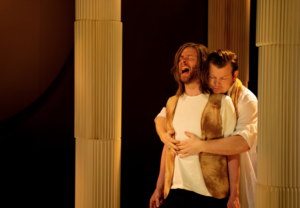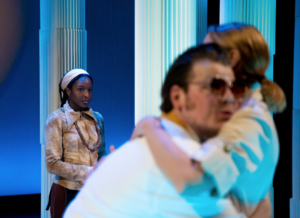(Editor’s note: An interview with the director and playwright is here.)
Show: De Tempel by Firma MES
Seen: April 20, 2023, Theater Dakota, The Hague
Out of all forms of art, the one that engages the most with the audience is theatre. This was most recently demonstrated to me by the play De Tempel (“The Temple”), written by Nic Bruckman and directed by Thomas Schoots. The performance spans the history of Peoples Temple transforming from an idealistic, inclusive church community step by step into a cult, fueled by Jones’ growing paranoia.
Nic Bruckman has studied Peoples Temple closely, but that does not mean that he adheres strictly to historical reality. For dramatic purposes here, for example, Jim Jones is married to a Black woman, but because he was too white for her church, and she was too black for his, they founded a church where everyone was welcomed.
Part 1: The service
The performance starts well. The first acts take place in the Peoples Temple church building, with a linoleum floor and paper pillars and orange-brown clothing. The frame – the audience becoming the congregation in a Peoples Temple church service during the chaotic 1970s, with actors planted among the theater-goers – works excellently. It gives the characters the opportunity to spread their loving, non-violent yet compelling beliefs over us. Jim Jones (Van den Dool) succeeds stunningly well in portraying the dangerous charisma of a cult leader: his disarming friendliness immediately wins you over.
There is already one dark foreshadowing: Jones says that as a five-year-old boy, he was already preaching to Jim Jones. Although he didn’t like chickens, they soon ate out of his hand. As such, he could easily twist their necks, he says, laughing. But as the church service continues, Jones’ call for love easily takes the upper hand again.
 In only a few public interventions he manages to convert a Vietnam veteran (Daan van Dijsseldonk), his rich girlfriend (Lindertje Mans), and a depressed young woman (Femke Brinksma) to his movement. The strong factor about the opening scene is that Schoots and Bruckman drop only the smallest of hints of the dark side, so that the audience members have to judge for themselves the merits of the “radical love” that Jones preaches.
In only a few public interventions he manages to convert a Vietnam veteran (Daan van Dijsseldonk), his rich girlfriend (Lindertje Mans), and a depressed young woman (Femke Brinksma) to his movement. The strong factor about the opening scene is that Schoots and Bruckman drop only the smallest of hints of the dark side, so that the audience members have to judge for themselves the merits of the “radical love” that Jones preaches.
It is easy to think that you – the objective spectator – would never follow such a church. But when the actors ask you to clap, to hug the person next to you or to stand up, everyone does. Of course, this is a fictional story with actors, but the short moments of audience participation make the peer pressure and solidarity evident on a small scale. In a very real sense, then, you yourself become a member of Peoples Temple.
In the second part, the emphasis shifts to the Jim Jones behind the scenes instead of behind the pulpit. This gradually reveals more of the darkness behind the solidarity. The scene in which Jones asks one of his followers for a transgressive favor is exemplary: Van den Dool and Van Dijsseldonk, opposite each other on their chair, perfectly embody the cult leader and the insecure follower. Like a predator closing in on its prey, Jones fluidly tilts the conversation from suggestive to outright abuse of power; one reviewer compared the homoerotic tension to the legendary confrontations between Philip Seymour Hoffman and Joaquin Phoenix in the film classic The Master.[1]
On the other hand, the character development of the rich friend (Lindertje Mans), who is manipulated from a skeptical outsider into Jones’ jungle queen, is too schematic to let her become a real character.
But, as Jones says in an aside in a key moment, “if you can convince someone he is better than the person he sees in the mirror, he is yours.” And Jones plays out this tactic scarily well.
The performance makes the smart choice not to let the violence come from Jones alone. The cult members do just as much violence to each other, to the point that the different members destroy each other, while Jones strolls between the pillars, almost disappearing into the background. Almost, but not entirely. He continues to direct his followers at crucial points. When doubts arise, he remains the one who gives people that final push towards the abyss. Any character who reveals an insecurity at the beginning is first convinced that they are safe in Peoples Temple, only to have that same insecurity thrown back in their face at the end.
Part 3: Guyana
When the paper columns, that initially functioned as the pillars of the Temple, transform into the trees in the South American jungle, De Tempel loses energy. It does show how the principles of radical love are abandoned as soon as the quality of the food (“rice with rice”) deteriorates. It fails, however, to let the audience understand what drives these people to commit the gruesome act Peoples Temple became known for. It is also difficult to depict a mass suicide with six actors; where the audience was an integral part of the show in the first part, the actors now merely tell what is happening. Especially after such a strong opening act, I considered this to be the weakest part of the performance.
Nevertheless, I enjoyed the play. Most portrayals of Peoples Temple place the most emphasis on the final day. It is good to see where and how the drama of Jonestown originated. And in times of manipulation, observing how manipulators work – and how they direct others to engage with them – does teach us a valuable lesson.
(Jeffrey Krul lives nearby Theater Dakota, The Hague, and happens to have an interest in the story of Peoples Temple.)
Note
[1] Voorspelbare blik op de gruwelijke ondergang van sekte Peoples Temple – NRC; 16 April 2023
